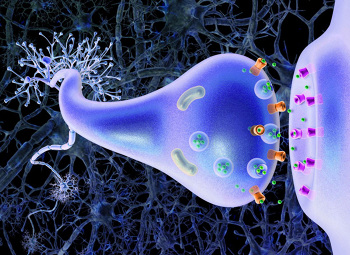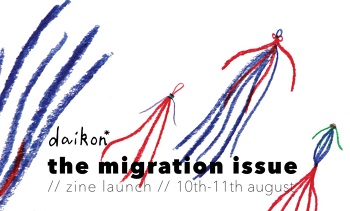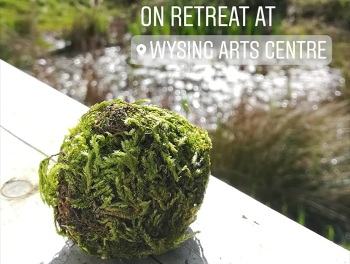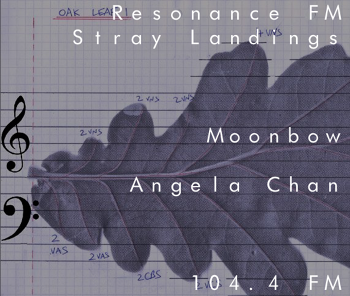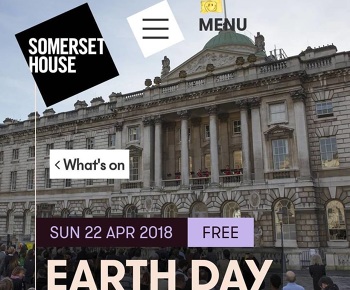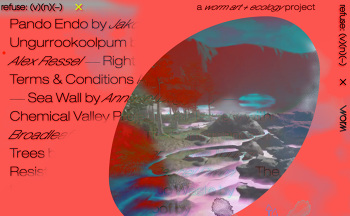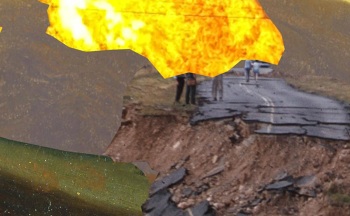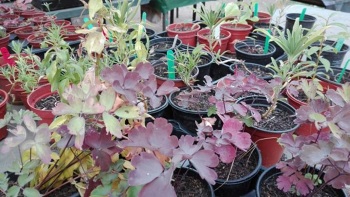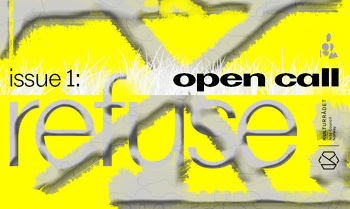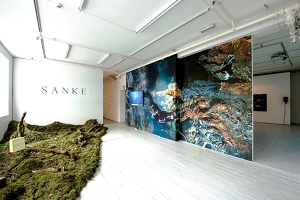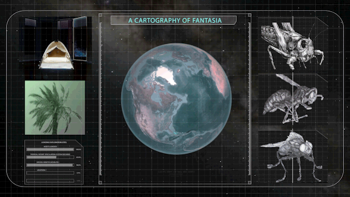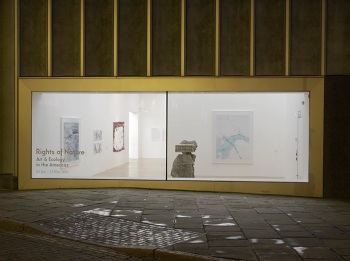Are Einari Skau from Spire on The United Nations Climate Change Conference: COP20/CMP10, Lima, Peru
[14/01/15]
Text-on-screen negotiations on the new climate agreement.
For over two decades, the United Nations have structured climate conferences as part of an international treaty to respond to climate change issues. The goal is to have international political bodies meet to discuss and negotiate how to work collectively to reduce greenhouse emissions, in order to tackle global warming. In addition, poverty, economic development, population growth, sustainable development and resource management are all urgent global issues interweaved with climate change, which must be addressed. Backed by many decades of scientific research, the UN Framework Convention on Climate Change utilises yearly conferences (COP) to evaluate the progress towards confronting the climate problem. For 2014, the COP20 was held in Lima, Peru between 1 – 14 December.
Are Einari Skau is a member of the Norwegian organisation Spire’s climate committee and will become its coordinator from February. He is also a student at Universitetet i Oslo’s Centre for Development and the Environment (SUM). Worm speaks to Are, who attended the 20th COP, to learn more about the role of UNFCCC and the COPs, and specifically how COP20 played out as the penultimate conference before a new International Climate Change Agreement must be reached in November 2015.
Are Einari Skau of Spire
Hello Are! Tell us about Spire and your participation with the Youth Constituency of the UN Framework Convention on Climate Change (UNFCCC).
Hi! Spire is an organisation that works for a sustainable world and just distribution of the world’s resources. We are an organisation that have a holistic view of the world. We seek to understand and communicate how different processes and structures in the world are interrelated, and how they affect people in Norway and around the world. We have three main topics that we focus on: international trade policy, food and agriculture, and climate. These are all closely interlinked, and policy changes in one of the realms will affect policy and practice in another.
I was at COP20 as a representative of the climate committee of Spire. As youth participants to the UN processes, we seek to influence the policy process, as well as creating awareness about issues we find important both at the negotiations and in the media et cetera back home. We try to influence the process through formal meetings, mass actions, lobbying and holding interventions on behalf of the constituency during the plenary negotiations.
Youth activists at an action for Intergenerational Equity
Youth representatives having a press conference about Intergenerational Equity, a concept that is getting traction rapidly at the moment.
What is the COP20 and what is at stake during these extensive talks?
The COP20 is the 20th session of the “Conference of the Parties”. It involves the state parties that signed the UN climate convention (with the UNFCCC), which was created after the Rio de Janeiro “Earth Summit” in 1992. The COP has been a yearly conference for the member states since then, to meet and negotiate on issues and agreements related to climate change. It didn’t take long after the climate convention was created before science showed that the targets of the convention are not enough to keep global warming within safe bounds. Therefore, negotiations were initiated to come to a more ambitious agreement based on the principles of the convention, which led to the creation of the Kyoto Protocol in 1997. The commitment periods of the Kyoto Protocol will expire in 2020. This means a new climate treaty has to be adopted prior to that. The UNFCCC has set a goal to reach agreement at COP21 in Paris in December this year. What was negotiated in Lima was the road to Paris, that is, what is going to be done during 2015, and a draft of what the Paris agreement could look like and what it should contain.
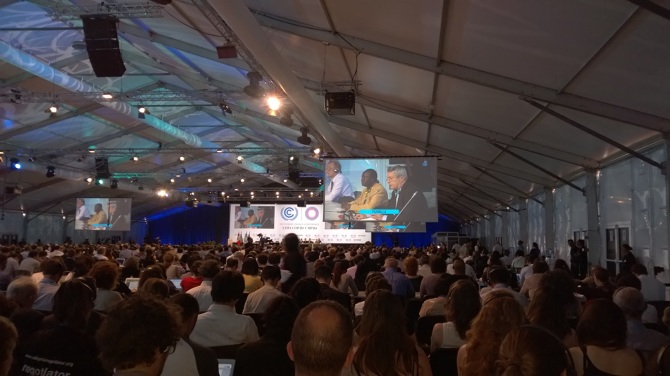
Tuvalu is one of the strong voices at the COP, being one of the countries that might soon disappear due to rising oceans.
As the agreement is decided to be bottoms up, countries should submit their intended, nationally determined contributions this year. A major line of divergence has been whether these should only include greenhouse gases (GHG) mitigation, or also include climate adaptation, mitigation, finance, loss and damage and technology transfer as well. Most developed countries only want mitigation to be included. But for developing country parties, the other elements are important, as they lack the means to mitigate and adapt both in terms of finance and technology.
During the year there are also inter-sessional meetings at least once. Given that 2015 is the ultimate deadline year, there will be many of these in Bonn and Geneva. Ban Ki-Moon, the Secretary-General of the United Nations, has also announced another emergency meeting in New York in June 2015, similar to the one in September 2014.
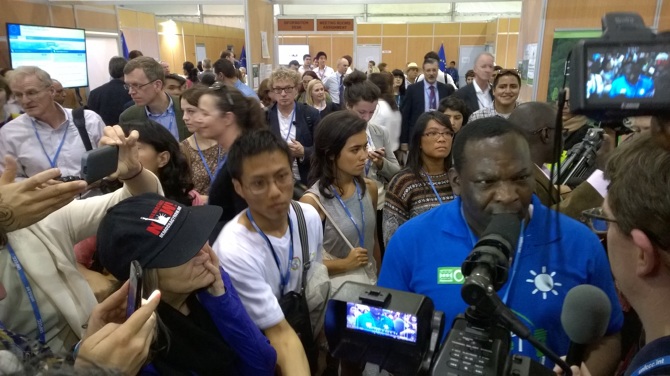
Godwin Uyi Ojo from Friends of the Earth Nigeria, interviewed at an action against a Shell/Chevron side event at the COP

Al Gore gave a speech at the ‘China Pavilion’
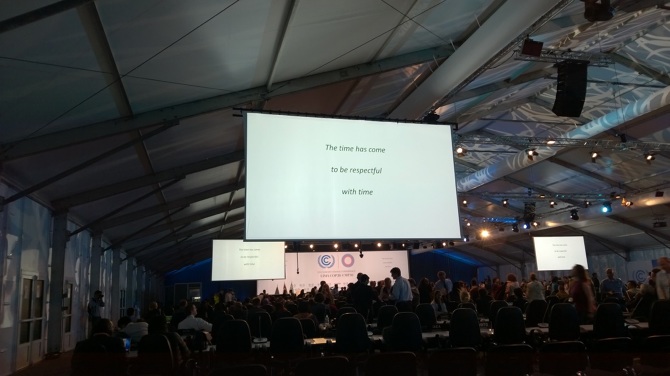
Towards the end of the negotiations, the secretariat is starting to get tired of long statements from the countries.
How have the negotiations been in terms of the atmosphere and progress towards the draft text for Paris 2015?
There were deep cleavages between different country blocks this year. In the first week, the negotiations were very polarised, and parties submitted mainly their extreme positions, choosing different kinds of hardliner tactics. At one point, the negotiations almost collapsed entirely. During the second week things moved slightly smoother during the ministerial talks. In the end, progress was not great, which is obvious when it took so long for parties to leave their extreme positions to try to reach convergence.
At the conference, the atmosphere felt nicer than in Warsaw COP19 though. But I’m not sure whether it was due to the nice venue and warm weather. I think it’s the first time a COP is held in an outdoor venue; it was really good.
The NGO party halfway through the COP is an important event for people to relax, have fun and socialise.
Peru is said to be a “dangerous place to be an environmentalist” (The Ecologist). How have delegates in Lima reacted to corporate land grabbing, deforestation, and the recent news of the suspected murder of Ecuadorian indigenous leader José Isidro Tendetza Antún?
Peru, as well as many other Latin- American countries, is a dangerous place to be an activist, in general. At the COP, civil society reacted by arranging solidarity actions, as well as press conferences to inform the public. The event did probably not affect the actual negotiations. Corporate land grabbing and deforestation are in general issues that are discussed a lot among the civil society representatives at the COP. Actions are held each year against the corporate influence over the climate negotiations, especially when these include fossil fuel companies.
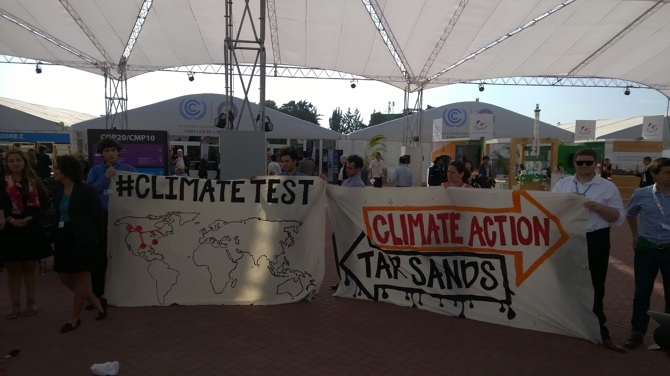
Action against tar sands, directed towards US Secretry of State John Kerry that paid the COP a visit.
There has been coverage on the Fast For Climate fasters and Greenpeace’s controversial and so-called vandalism on the Nazca lines. How have you experienced how eco-activists are involved both in and around COP20?
An important role of the COPs are the mobilising effect they have, and all the attention they create. People from all around the world travel far to wherever the COPs are, even if they are not accredited to go to the actual conference. During the COP Lima, it was full of activists of all kinds, doing all sorts of actions. I have participated in many myself, including acting, music, flash mobs, good old chanting and banners and so on. There was the climate march, which was the biggest single action, and the biggest manifestation in Peru for years.
The Fast for Climate action was born in COP19 in Warsaw last year, when the lead negotiator of the Filippines, Yeb Saño, announced that he would fast until substantial progress was made at the negotiations. The context was the devastating hurricane Haiyan that hit the Filippines few days before the COP.
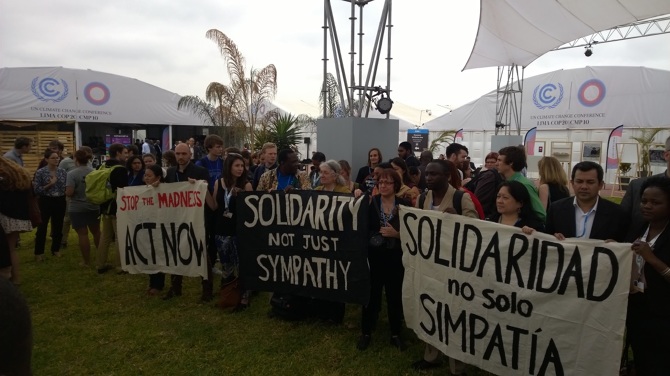
Civil society demands solidarity, not just sympathy with hurricane victims in the Philippines
Civil Society representatives present at the COP decided to fast in solidarity with Yeb and the people of the Philippines. The fasters are not a confined group of people, and anyone who would like to join the solidarity fasting can get a red button badge to show this. During the year some people have fasted one day a month in solidarity, as well as both Mondays at COP20.
A not so fun fact is that Yeb Sano was fired before COP20, allegedly after pressure from the EU and US who found him to be to “noisy” and radical.
The Fossil of the Day is the most famous civil society action during COP. Every day the worst players in the negotiations get a Fossil award. Saudi-Arabia and Australia are often champions.
The Nazca line action of Greenpeace got huge and negative attention in Peru. I can’t understand how no one in Greenpeace thought of that action being a really stupid idea before it was too late. It is sad, because Greenpeace is a great organisation that knows very well how to do very effective campaigns and actions. It will probably take a long time for them to rebuild trust in Peru after the Nazca scandal.
Is there anything else you believe is important to add?
The most important issue now is climate justice. That means that those who have the biggest responsibility for the problems we face due to climate change must take on the greatest action. Climate change affects everyone, but it doesn't hit justly. Those who are the least responsible for climate change are the hardest affected, and have the least means to cope with climate change. These are poor countries in vulnerable areas. Rich countries must act according to their historical responsibility for climate change, as well as provide support for those who are the worst affected.
All photos and their captions are by Are Einari Skau. More detailed information about the UNFCCC can be found on this link.
---
Follow Are Einari Skau on twitter: @skauare
Follow Spire:
Website: https://www.spireorg.no
Twitter: @spireorg
Blog: spirebloggen.no
Text-on-screen negotiations on the new climate agreement.
For over two decades, the United Nations have structured climate conferences as part of an international treaty to respond to climate change issues. The goal is to have international political bodies meet to discuss and negotiate how to work collectively to reduce greenhouse emissions, in order to tackle global warming. In addition, poverty, economic development, population growth, sustainable development and resource management are all urgent global issues interweaved with climate change, which must be addressed. Backed by many decades of scientific research, the UN Framework Convention on Climate Change utilises yearly conferences (COP) to evaluate the progress towards confronting the climate problem. For 2014, the COP20 was held in Lima, Peru between 1 – 14 December.
Are Einari Skau is a member of the Norwegian organisation Spire’s climate committee and will become its coordinator from February. He is also a student at Universitetet i Oslo’s Centre for Development and the Environment (SUM). Worm speaks to Are, who attended the 20th COP, to learn more about the role of UNFCCC and the COPs, and specifically how COP20 played out as the penultimate conference before a new International Climate Change Agreement must be reached in November 2015.
Are Einari Skau of Spire
Hello Are! Tell us about Spire and your participation with the Youth Constituency of the UN Framework Convention on Climate Change (UNFCCC).
Hi! Spire is an organisation that works for a sustainable world and just distribution of the world’s resources. We are an organisation that have a holistic view of the world. We seek to understand and communicate how different processes and structures in the world are interrelated, and how they affect people in Norway and around the world. We have three main topics that we focus on: international trade policy, food and agriculture, and climate. These are all closely interlinked, and policy changes in one of the realms will affect policy and practice in another.
I was at COP20 as a representative of the climate committee of Spire. As youth participants to the UN processes, we seek to influence the policy process, as well as creating awareness about issues we find important both at the negotiations and in the media et cetera back home. We try to influence the process through formal meetings, mass actions, lobbying and holding interventions on behalf of the constituency during the plenary negotiations.
Youth activists at an action for Intergenerational Equity
Youth representatives having a press conference about Intergenerational Equity, a concept that is getting traction rapidly at the moment.
What is the COP20 and what is at stake during these extensive talks?
The COP20 is the 20th session of the “Conference of the Parties”. It involves the state parties that signed the UN climate convention (with the UNFCCC), which was created after the Rio de Janeiro “Earth Summit” in 1992. The COP has been a yearly conference for the member states since then, to meet and negotiate on issues and agreements related to climate change. It didn’t take long after the climate convention was created before science showed that the targets of the convention are not enough to keep global warming within safe bounds. Therefore, negotiations were initiated to come to a more ambitious agreement based on the principles of the convention, which led to the creation of the Kyoto Protocol in 1997. The commitment periods of the Kyoto Protocol will expire in 2020. This means a new climate treaty has to be adopted prior to that. The UNFCCC has set a goal to reach agreement at COP21 in Paris in December this year. What was negotiated in Lima was the road to Paris, that is, what is going to be done during 2015, and a draft of what the Paris agreement could look like and what it should contain.

Tuvalu is one of the strong voices at the COP, being one of the countries that might soon disappear due to rising oceans.
As the agreement is decided to be bottoms up, countries should submit their intended, nationally determined contributions this year. A major line of divergence has been whether these should only include greenhouse gases (GHG) mitigation, or also include climate adaptation, mitigation, finance, loss and damage and technology transfer as well. Most developed countries only want mitigation to be included. But for developing country parties, the other elements are important, as they lack the means to mitigate and adapt both in terms of finance and technology.
During the year there are also inter-sessional meetings at least once. Given that 2015 is the ultimate deadline year, there will be many of these in Bonn and Geneva. Ban Ki-Moon, the Secretary-General of the United Nations, has also announced another emergency meeting in New York in June 2015, similar to the one in September 2014.

Godwin Uyi Ojo from Friends of the Earth Nigeria, interviewed at an action against a Shell/Chevron side event at the COP

Al Gore gave a speech at the ‘China Pavilion’

Towards the end of the negotiations, the secretariat is starting to get tired of long statements from the countries.
How have the negotiations been in terms of the atmosphere and progress towards the draft text for Paris 2015?
There were deep cleavages between different country blocks this year. In the first week, the negotiations were very polarised, and parties submitted mainly their extreme positions, choosing different kinds of hardliner tactics. At one point, the negotiations almost collapsed entirely. During the second week things moved slightly smoother during the ministerial talks. In the end, progress was not great, which is obvious when it took so long for parties to leave their extreme positions to try to reach convergence.
At the conference, the atmosphere felt nicer than in Warsaw COP19 though. But I’m not sure whether it was due to the nice venue and warm weather. I think it’s the first time a COP is held in an outdoor venue; it was really good.
The NGO party halfway through the COP is an important event for people to relax, have fun and socialise.
Peru is said to be a “dangerous place to be an environmentalist” (The Ecologist). How have delegates in Lima reacted to corporate land grabbing, deforestation, and the recent news of the suspected murder of Ecuadorian indigenous leader José Isidro Tendetza Antún?
Peru, as well as many other Latin- American countries, is a dangerous place to be an activist, in general. At the COP, civil society reacted by arranging solidarity actions, as well as press conferences to inform the public. The event did probably not affect the actual negotiations. Corporate land grabbing and deforestation are in general issues that are discussed a lot among the civil society representatives at the COP. Actions are held each year against the corporate influence over the climate negotiations, especially when these include fossil fuel companies.

Action against tar sands, directed towards US Secretry of State John Kerry that paid the COP a visit.
There has been coverage on the Fast For Climate fasters and Greenpeace’s controversial and so-called vandalism on the Nazca lines. How have you experienced how eco-activists are involved both in and around COP20?
An important role of the COPs are the mobilising effect they have, and all the attention they create. People from all around the world travel far to wherever the COPs are, even if they are not accredited to go to the actual conference. During the COP Lima, it was full of activists of all kinds, doing all sorts of actions. I have participated in many myself, including acting, music, flash mobs, good old chanting and banners and so on. There was the climate march, which was the biggest single action, and the biggest manifestation in Peru for years.
The Fast for Climate action was born in COP19 in Warsaw last year, when the lead negotiator of the Filippines, Yeb Saño, announced that he would fast until substantial progress was made at the negotiations. The context was the devastating hurricane Haiyan that hit the Filippines few days before the COP.

Civil society demands solidarity, not just sympathy with hurricane victims in the Philippines
Civil Society representatives present at the COP decided to fast in solidarity with Yeb and the people of the Philippines. The fasters are not a confined group of people, and anyone who would like to join the solidarity fasting can get a red button badge to show this. During the year some people have fasted one day a month in solidarity, as well as both Mondays at COP20.
A not so fun fact is that Yeb Sano was fired before COP20, allegedly after pressure from the EU and US who found him to be to “noisy” and radical.
The Fossil of the Day is the most famous civil society action during COP. Every day the worst players in the negotiations get a Fossil award. Saudi-Arabia and Australia are often champions.
The Nazca line action of Greenpeace got huge and negative attention in Peru. I can’t understand how no one in Greenpeace thought of that action being a really stupid idea before it was too late. It is sad, because Greenpeace is a great organisation that knows very well how to do very effective campaigns and actions. It will probably take a long time for them to rebuild trust in Peru after the Nazca scandal.
Is there anything else you believe is important to add?
The most important issue now is climate justice. That means that those who have the biggest responsibility for the problems we face due to climate change must take on the greatest action. Climate change affects everyone, but it doesn't hit justly. Those who are the least responsible for climate change are the hardest affected, and have the least means to cope with climate change. These are poor countries in vulnerable areas. Rich countries must act according to their historical responsibility for climate change, as well as provide support for those who are the worst affected.
All photos and their captions are by Are Einari Skau. More detailed information about the UNFCCC can be found on this link.
---
Follow Are Einari Skau on twitter: @skauare
Follow Spire:
Website: https://www.spireorg.no
Twitter: @spireorg
Blog: spirebloggen.no



